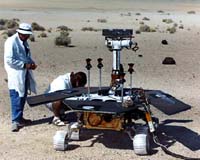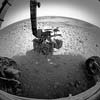
JPL engineers prepare a prototype MER rover for action at the edge of Rogers Dry Lake near NASA Dryden Flight Research Center. NASA photo by Tom Tschida.
 JPL engineers prepare a prototype MER rover for action at the edge of Rogers Dry Lake near NASA Dryden Flight Research Center. NASA photo by Tom Tschida. |
When NASA's Jet Propulsion Laboratory (JPL) engineers in Pasadena, Calif., started looking for suitable, Mars-like terrain to try out the navigation software aboard an earthbound prototype rover, they picked the edge of a dry lakebed at NASA's Dryden Flight Research Center at Edwards Air Force Base, Calif.
NASA Dryden and Edwards are located at Rogers Dry Lake, a hard and huge desert surface perfect for emergency landings of exotic experimental aircraft. That's why the Air Force originally chose the site to test new experimental jets during World War II. A short while later, and for the same reasons, NASA's predecessor, the National Advisory Committee for Aeronautics, set up shop at the edge of the lakebed.
Visible from space, Rogers Dry Lake, with an area of 44 square miles, is the largest of many dry lakes in California's Mojave Desert. It is a National Historic Landmark because of its role in the development of the nation's aerospace achievements. Early Space Shuttle flights landed on Rogers Dry Lake. At one time the lakebed contained water year round, but due to changing geographical and weather patterns, it is hard and dry most of the year, holding shallow water only briefly after infrequent desert rains.
Last June, even after the first rover, Spirit, was well on its way to the Red Planet to land in Gusev Crater, believed by scientists to contain a dry lakebed similar to ones on Earth, JPL engineers put the prototype through its paces at Rogers Lake. Researchers had the prototype determine its own location, navigate around and over small hills, and maneuvering to avoid obstacles.
Before heading out for Mars, much rover evaluation had already been accomplished. Many thousands of hours of research and labor went into assuring the twin Mars rovers have the best possible chances for success.
The rover team learned valuable lessons through the Rogers Lake evaluations, as they continued polishing the software. Their success in the desert provided more confidence in the software for the tremendous challenge of directing both rovers in the exploration of Mars.
The refining of the rovers' software continued after launch on their seven-month journeys, because new commands can be sent to the rovers from Earth even after they have landed on Mars. If needed, a total software reload can be accomplished from Earth.
Related Links
 Pasadena - Jan 19, 2004
Pasadena - Jan 19, 2004SPACE.WIRE |